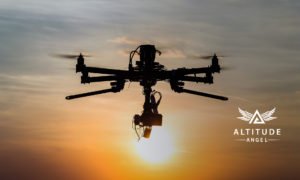Telecom giant BT and leading UTM solutions provider Altitude Angel will lead a consortium to develop a UK drone corridor.
“BT took a significant leap into the commercial drones market today, as the company announced, alongside Altitude Angel, the formation of a new consortium to deliver a series of industry use cases across the UK’s first commercial drone corridor,” says an Altitude Angel press release.
BT, Altitude Angel, and several tech start-ups have been selected by UK Research and Innovation to collaborate on “Project XCelerate” – a future flight drones project which will establish new use cases for a UK drone corridor south of Reading, Berkshire.
A “Superhighway in the Sky”
In summer 2021, the project will conduct flight trials along the 8km-long UK drone corridor, demonstrating the safe integration of drones and manned aircraft. “The consortium will demonstrate key industry use cases across healthcare, emergency services and infrastructure to illustrate how drone deliveries and inspection can bring countless benefits to businesses, the public sector and UK citizens,” says Altitude Angel.
“Through Project Xcelerate, we’re bringing together our world leading UTM technology, combining it with BT’s vast experience in network communications, and applying it to the Arrow Drone Zone in the Thames Valley, just west of London,” says Richard Parker, Altitude Angel CEO and founder. “The Project will demonstrate how the current blockers to regular, highly automated drone flights – most notably the ability to safely and securely fly BVLOS in unregulated or open airspace – can be overcome. Once this has been demonstrated we’ll be able to start rolling out other corridors, say between two hospitals with complementary lab and research facilities or joining local airports with other travel infrastructure to create transport hubs. Eventually, we’ll be able to link these corridors, creating a super-highway network in the sky.”
BT is demonstrating their technology and expertise as part of the UK drone corridor project. Gerry McQuade, CEO of BT’s Enterprise unit, said: “As drone numbers continue to rise, there is an urgent need to safely integrate commercial drones into global airspace alongside manned aviation. In showing how drones can deliver improved, potentially life-saving services to the public, we’re aiming to accelerate the adoption of fully automated drones in unrestricted UK airspace in a safe and responsible way.”
“From improved mobility, connectivity, healthcare and manufacturing output, to reduced road congestion and pollution, automated drone technology will transform the quality of our lives. BT’s role in the consortium is to bring world-leading drone expertise together and to provide the secure and resilient mobile network connectivity, as well as our drone detection services. The power of EE’s 4G and 5G networks will ensure commercial drones remain connected for greater situational awareness, accurate positioning and to avoid collisions – ensuring that they can be operated safely and responsibly across UK skies.”
Emergency Services, Infrastructure Inspections
“The key use cases which will be explored by the consortium include using drones to assist the emergency services, for example during road traffic collisions and search and rescue missions,” says Altitude Angel. “Using 3D mapping techniques, drones can be used for forensics purposes to aid the police when responding to road traffic collisions and can also help to locate missing persons during search and rescue missions. Project XCelerate will prove how drone technology can be used to speed up response times for such incidents, helping the emergency services to improve the chances of survival, whilst also reducing costs.”
The UK drone corridor project will also demonstrate “how automated drones can reduce the lead times for urgently needed medical deliveries, helping the healthcare and pharmaceutical sectors to improve standards of patient care. A further use case is key infrastructure inspection, where drones can be used to help assess damage or maintenance required for critical national infrastructure for the utilities, telecoms and transport sectors,” says Altitude Angel.
Miriam McNabb is the Editor-in-Chief of DRONELIFE and CEO of JobForDrones, a professional drone services marketplace, and a fascinated observer of the emerging drone industry and the regulatory environment for drones. Miriam has penned over 3,000 articles focused on the commercial drone space and is an international speaker and recognized figure in the industry. Miriam has a degree from the University of Chicago and over 20 years of experience in high tech sales and marketing for new technologies.
For drone industry consulting or writing, Email Miriam.
TWITTER:@spaldingbarker
Subscribe to DroneLife here.
